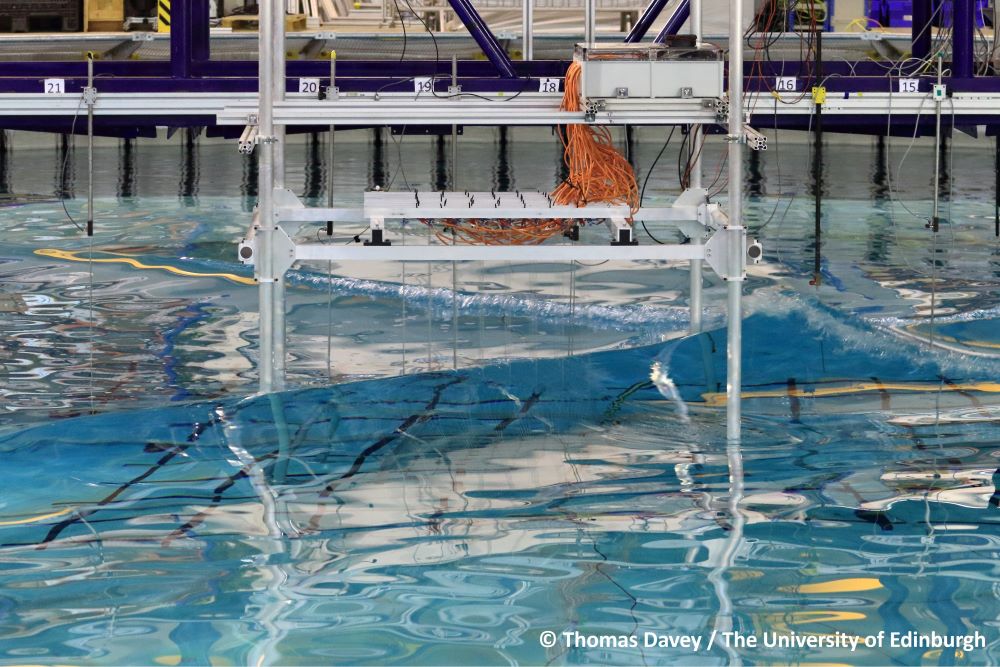Unusual waves grow way beyond known limits
Waves that come from multiple directions are extremer than extreme. These remarkable deep-sea waves can be four times steeper than what was previously imagined, as is shown in research by TU Delft and other universities that was published in Nature today.
A long time ago, stories were told of mysterious rogue waves that materialised out of nowhere and could topple even the largest ships. These waves lost their mythical character when the first rogue wave was recorded at the Draupner platform in the North Sea.
In 2018, Ton van den Bremer and his colleagues at the Universities of Edinburgh and Oxford managed to recreate the Draupner wave in the lab for the first time ever, and this opportunity to study freak waves closely produced unexpected insights.
Multiple waves push up water
New research by the research consortium now shows that these remarkable waves do not break when traditional theories hold they should, the secret behind which lies in how they arise. Ton van den Bremer, expert on fluid mechanics at TU Delft and led the study, explains: “When most people think of waves, they think of the rolling waves you’d find on a beach. The type of wave we studied occurs in open water and arises when waves coming from multiple directions come together. When these waves with a high directional spread converge, the water is pushed upwards, forming a partially standing wave. An example of this is known as a crossing wave.
How crossing waves arise
Under certain conditions at sea, waves from multiple directions occur. This can happen in a place where two seas meet, or where winds suddenly change direction, as in a hurricane. When waves from two directions meet, a cross wave occurs, provided their directions are far enough apart. The study also shows that the further apart the directions are, the higher the resulting cross-wave.
Travelling waves break when they reach a certain limit, this is when they reach their maximum steepness. The study shows that waves with a multidirectional spreading can get as much as 80% steeper than this limit before they start breaking, which means they can get almost twice as high as ‘normal waves’ before they start to break.
Travelling wave (l) and a wave with high directional spreading (r)
Breaking waves that grow
Next, the researchers found another highly unusual phenomenon that defies existing theories, a phenomenon that is unprecedented according to Van den Bremer: “Once a conventional wave breaks, it forms a white cap, and there is no way back. But when a wave with a high directional spreading breaks, it can keep growing.” The study shows that these enormous waves can grow to twice their original steepness while breaking, which is already twice bigger than the conventional limit. Together, the waves can grow four times steeper than previously thought possible.
Damage to offshore structures
The knowledge that multidirectional waves can become as much as four times larger than was deemed possible can help design safer marine structures. "The three-dimensionality of waves is often overlooked in the design of offshore wind turbines and other structures in general; our findings suggest this leads to designs that are less reliable", says Mark McAllister of the University of Oxford, who led the experiments and is now a senior scientist at Wood Thilsted.
Innovative vertical sensors made it possible to take accurate 3D measurements of waves.
Innovative 3D measurement method
A 3D measurement method developed in the FloWave lab paved the way for these new insights. “Conventional 2D wave measurement methods weren’t up to the task”, Van den Bremer explains, which is why the research group designed a new way to create 3D wave measurements. Ross Calvert of the University of Edinburgh: “This is the first time we've been able to measure wave heights at such high spatial resolution over such a big area, giving us a much more detailed understanding of complex wave breaking behaviour."



